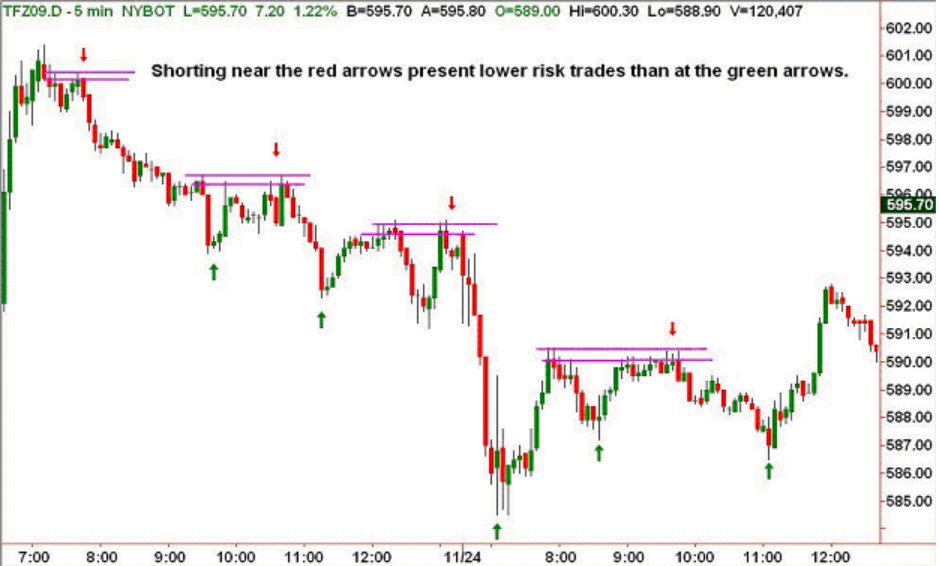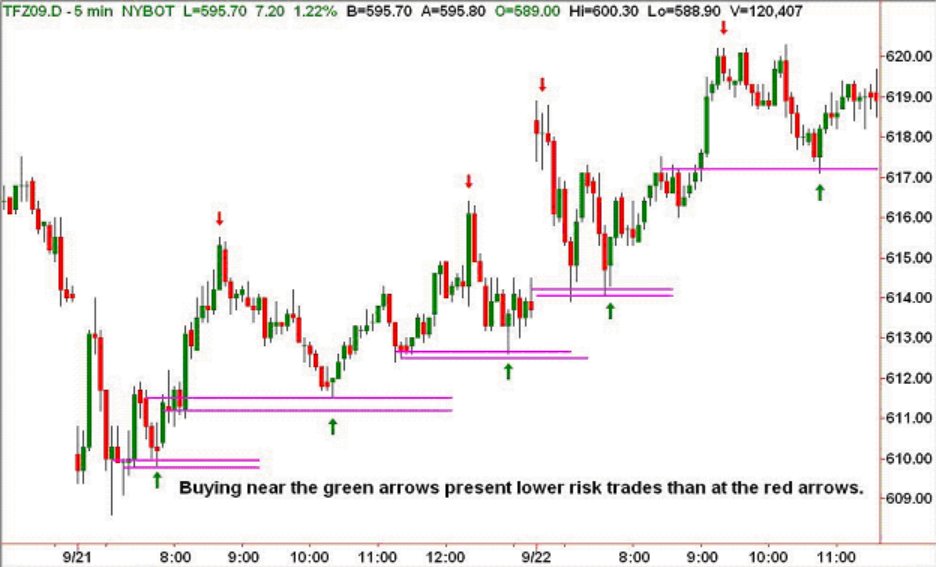I have previously discussed the fractal nature of markets and specifically the fact that there are always smaller tendencies contained within the larger more dominating trends. Also the old Wall Street maxim "buy low, sell dear," adding that though this concept is seemingly easy to understand, the reality of putting it into practice is a bit more challenging.
In this article, I'm going to elaborate on the notion of buying when prices are moving lower, and selling, or shorting, when prices are heading higher, all within the context of a trend. This concept is sometimes hard for new traders to understand, as it seems to run contradictory to trading in the direction of the line of least resistance.
I often get a bewildered look from students when I say to them "now that we have identified a distinct downtrend, we'll look to short on the first rally into resistance." Their first response is usually "why not short now when it's moving lower?" I reply that it is not a low risk trade to short any financial instrument after a prolonged period of selling, as the risk becomes elevated. In other words, the further price travels away from the mean, the riskier it is to trade in that direction. By the mean, I'm referencing the level of equilibrium where buyers and sellers were fairly matched before the move began. The lowest risk opportunities in this scenario are found at prior selling zones. Below we can see these "prior selling zones" and how having the patience to wait for these particular setups paid handsomely.

Conversely, the majority of traders who are conditioned to sell after a series of red candles (green arrows) lose even though they are indeed trading in the direction of the trend. These latecomers are the folks that immediately have to cover their short positions when the trade moves against them. They put a bid under the market, thus causing the countermoves that are normal in trends.
In the next example below, we examine an uptrend in force and we notice that buying into prior support areas were, again, the better trades in terms of risk versus reward.

Let's change gears somewhat and continue with this theme on a contemporary level. In the macro sense, a lot was made of the market's sizeable gap lower on Black Friday. The massive selloff - at one point 35 points lower in the S&P E-mini - was attributed to Dubai's trouble in paying a large outstanding debt that had come due. The dramatic overnight reaction brought back the spectre of another global credit crisis and all its implications. Since the Futures market was open most of the day on Thanksgiving, word began to spread like wildfire. I heard a lot of "here we go again" discourse from a large segment of the trading community.
I must say, in a more negative environment, I would have expected a continuation of the selling and perhaps the large gap to be a real game changer regarding the larger trend. However, two things gave me pause as to the most likely outcome (a big down day).
First, the idea of buying low is how I operate when I trade. So a gap lower opening, into a support zone, in the context of an uptrend, is usually a buy. Secondly, if you think about the psychology of the market for the last six months, you know that investors have been rewarded for buying every correction, regardless of all the negative stories being disseminated, or of the divergent signals the market has been throwing off lately. And yes, there are some yellow flags out there - the fact of the matter is that the current psychology will only be broken when investors cease to be compensated for buying stocks when they pullback. And as we've seen, the major market averages continue to defy the doomsayers thus far. What's more, the charts will begin to depict a change in the supply/demand quotient well before you hear about it in any media outlet or from any pundit.
For now, swing traders and investors should continue buying on the dips as this course of action has been paying better and more frequently than being short. When this pattern no longer works, that is the first signal that the market is changing its stripes. On an intraday basis, however, flexibility is key, as the short-term environment is changing almost daily.
All told, there are times when mass psychology dominates the landscape in the big picture. As traders, we have to understand and navigate through this setting, always looking for our personal advantage. I've found that for me," buying the dips and selling the rips" works.
In this article, I'm going to elaborate on the notion of buying when prices are moving lower, and selling, or shorting, when prices are heading higher, all within the context of a trend. This concept is sometimes hard for new traders to understand, as it seems to run contradictory to trading in the direction of the line of least resistance.
I often get a bewildered look from students when I say to them "now that we have identified a distinct downtrend, we'll look to short on the first rally into resistance." Their first response is usually "why not short now when it's moving lower?" I reply that it is not a low risk trade to short any financial instrument after a prolonged period of selling, as the risk becomes elevated. In other words, the further price travels away from the mean, the riskier it is to trade in that direction. By the mean, I'm referencing the level of equilibrium where buyers and sellers were fairly matched before the move began. The lowest risk opportunities in this scenario are found at prior selling zones. Below we can see these "prior selling zones" and how having the patience to wait for these particular setups paid handsomely.

Conversely, the majority of traders who are conditioned to sell after a series of red candles (green arrows) lose even though they are indeed trading in the direction of the trend. These latecomers are the folks that immediately have to cover their short positions when the trade moves against them. They put a bid under the market, thus causing the countermoves that are normal in trends.
In the next example below, we examine an uptrend in force and we notice that buying into prior support areas were, again, the better trades in terms of risk versus reward.

Let's change gears somewhat and continue with this theme on a contemporary level. In the macro sense, a lot was made of the market's sizeable gap lower on Black Friday. The massive selloff - at one point 35 points lower in the S&P E-mini - was attributed to Dubai's trouble in paying a large outstanding debt that had come due. The dramatic overnight reaction brought back the spectre of another global credit crisis and all its implications. Since the Futures market was open most of the day on Thanksgiving, word began to spread like wildfire. I heard a lot of "here we go again" discourse from a large segment of the trading community.
I must say, in a more negative environment, I would have expected a continuation of the selling and perhaps the large gap to be a real game changer regarding the larger trend. However, two things gave me pause as to the most likely outcome (a big down day).
First, the idea of buying low is how I operate when I trade. So a gap lower opening, into a support zone, in the context of an uptrend, is usually a buy. Secondly, if you think about the psychology of the market for the last six months, you know that investors have been rewarded for buying every correction, regardless of all the negative stories being disseminated, or of the divergent signals the market has been throwing off lately. And yes, there are some yellow flags out there - the fact of the matter is that the current psychology will only be broken when investors cease to be compensated for buying stocks when they pullback. And as we've seen, the major market averages continue to defy the doomsayers thus far. What's more, the charts will begin to depict a change in the supply/demand quotient well before you hear about it in any media outlet or from any pundit.
For now, swing traders and investors should continue buying on the dips as this course of action has been paying better and more frequently than being short. When this pattern no longer works, that is the first signal that the market is changing its stripes. On an intraday basis, however, flexibility is key, as the short-term environment is changing almost daily.
All told, there are times when mass psychology dominates the landscape in the big picture. As traders, we have to understand and navigate through this setting, always looking for our personal advantage. I've found that for me," buying the dips and selling the rips" works.
Last edited by a moderator:
